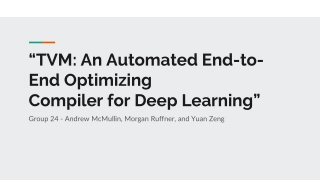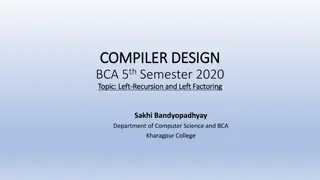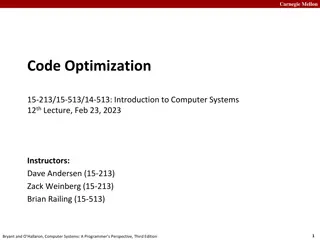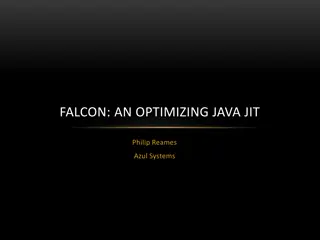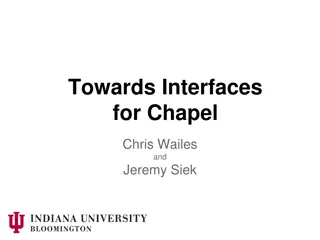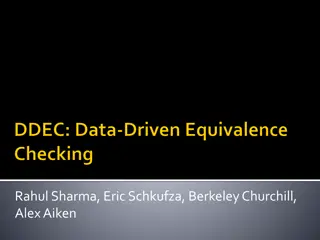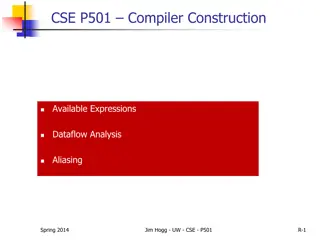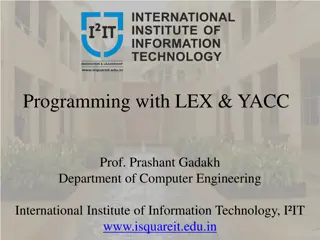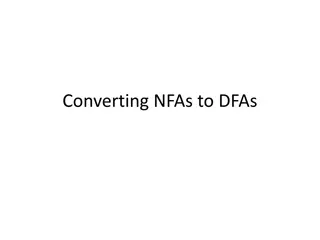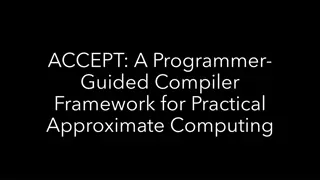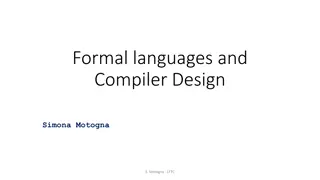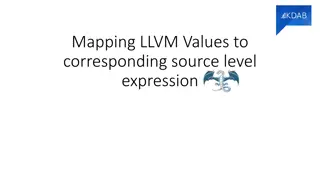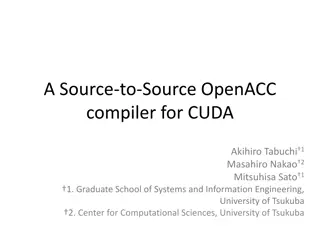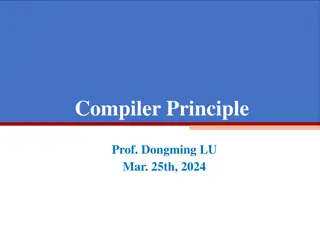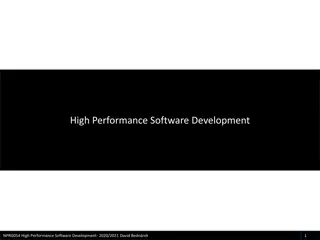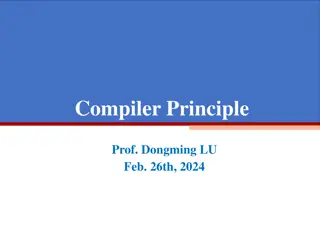Understanding the open-source P4 Compiler
The open-source P4 compiler is a tool designed to support the evolution of P4 by generating code for various networks and devices. This presentation covers the goals of the compiler, what you need to know to write compiler code, the compiler architecture, intermediate representation, visitors, compiler structure, nanopass architecture, and more. With a focus on enhancing P4's capabilities, this resource aims to provide insights into modifying the compiler to align with specific requirements.
Download Presentation

Please find below an Image/Link to download the presentation.
The content on the website is provided AS IS for your information and personal use only. It may not be sold, licensed, or shared on other websites without obtaining consent from the author.If you encounter any issues during the download, it is possible that the publisher has removed the file from their server.
You are allowed to download the files provided on this website for personal or commercial use, subject to the condition that they are used lawfully. All files are the property of their respective owners.
The content on the website is provided AS IS for your information and personal use only. It may not be sold, licensed, or shared on other websites without obtaining consent from the author.
E N D
Presentation Transcript
Understanding the open-source P416compiler February 15, 2022 P4 developer days Mihai Budiu (mbudiu-vmw) mbudiu@vmware.com
What is this about? P4 is a programming language for network dataplanes Current spec at https://p4.org/p4-spec/docs/P4-16-v1.2.2.html Open-source reference implementation: http//github.com/p4lang/p4c [Apache 2 license] This presentation should explain how you can modify this compiler Additional details in https://github.com/p4lang/p4c/blob/main/docs/compiler-design.pptx 2
Compiler goals Support evolution of P4 Support multiple back-ends Generate code for ASICs, NICs, FPGAs, software switches, and other targets Provide support for other tools (debuggers, IDEs, control-plane, etc.) Extensible architecture: easy to add new: Targets Language extensions Passes Optimizations 3
What do I need to know to write compiler code? C++ (11) We use garbage-collected C++ Looks more like Java (no delete) How to install the sources and build the binaries Your target The P416 spec The separation between language and architecture model The compiler intermediate representation (IR) structure Compilation using visitors In this presentation 4
Presentation Outline Compiler architecture Intermediate Representation (IR) Visitors 5
Compiler structure IR with target-specific extensions Same IR Parser Front-end Mid-end Back-end P4 IR IR IR output Target-independent Target-specific 6
Structure Library of pre-built passes Fixed Custom Mix and match Front-end Mid-end Back-end P4 IR IR main() frontends/p4/* midend/* backends/* 7
Nanopass architecture Very simple passes Lots of them ./p4c-ebpf v ../testdata/p4-16-samples/count_ebpf.p4 FrontEnd_0_P4V1::getV1ModelVersion ParseAnnotationBodies_0_ParseAnnotations ParseAnnotationBodies_1_ClearTypeMap FrontEnd_1_ParseAnnotationBodies FrontEnd_2_PrettyPrint MidEnd_26_ParsersUnroll MidEnd_27_EvaluatorPass MidEnd_28_MidEndLast 378 passes! (not all different) 8
P4 Language Layered Design Syntactic sugar Core language Front-end/ mid-end Core language Back-end Target language Many language constructs are eliminated entirely in the front-end/mid-end Syntactic sugar constructs are thus automatically supported by all back-ends 9
IR (Intermediate Representation) ir/ir.h ir/*.def 10
Intermediate Representation A Object-oriented Immutable Strongly-typed (hard to build incorrect programs) Directed Acyclic Graph (DAG) structure No parent pointers Sub-DAGs can be shared Manipulated almost exclusively by visitors B C shared sub-DAG 11
*.def files Provide the definition of the IR classes def language is a custom very small sub-set of C++ Front-end IR classes are in ir/*.def IR class hierarchy can be extended by backends $ ls ../ir/*.def ir/base.def ir/expression.def ir/ir.def ir/type.def ir/v1.def All expressions Base classes Other classes All types P4-14 12
A fragment of expression.def abstract Operation_Binary : Operation { Expression left; Expression right; } abstract Expression {} abstract Operation : Expression { virtualint getPrecedence() const = 0; virtual cstring getStringOp() const = 0; class Add : Operation_Binary { stringOp = "+"; precedence = DBPrint::Prec_Add; } } abstract Operation_Unary : Operation { Expression expr; } Operation_Binary class Neg : Operation_Unary { left right stringOp = "-"; } Expression Expression 13
Everything descends from Node Generated C++ namespace IR{ class Expression : publicNode { } class Operation : public Expression { virtualint getPrecedence() const = 0; virtual cstring getStringOp() const = 0; } class Operation_Binary : public Operation { public: const IR::Expression* left = nullptr; const IR::Expression* right = nullptr; } } // namespace Class hierarchy IR fields Strongly typed 14
Front-end IR IR::Expression base class for all expressions IR::Type base class for all types IR::Statement base class for all statements IR::Declaration base class for many declarations IR::Type_Declaration base class for declarations that are also types A few other constructs P4Parser, P4Table, P4Control, Function, etc. 15
Other IR Classes IR::Node base of whole class hierarchy IR::Vector<T> where T is an IR::Node IR::IndexedVector<T> Like vector, but maintains a hash-table for IDeclarations for quick look-up by name Rejects multiple declarations with the same name IR::ID Represents an identifier (including source position) Stores both the original name (provided by user) and the new internal name 16
The IR tree and the P4 parser The P4 parser is written in bison frontend/parsers/p4/p4parser.ypp It explains how P4 constructs are represented lvalue '=' expression ';' { $$ = new IR::AssignmentStatement(@2, $1, $3); } expression: | expression "+" expression { $$ = new IR::Add(@1 + @3, $1, $3); } 17
Understanding the IR This may seem daunting P4 grammar IR (very close correspondence) If you understand the language, you understand most of the front-end IR However, a few IR classes have no direct correspondence with language You can probably ignore these 18
IR <=> P4 IR serializable to a P4 program Simplifies debugging and testing To read the IR: just generate and read P4 Example: p4c-ebfp --top4 MidEndLast [ ]count_ebpf.p4 Dumps program after pass MidEndLast is executed Output written in count_ebpf-MidEnd_28_MidEndLast.p4 19
Generate IR As P4 Comments ParserState $ p4c-ebfp --top4 MidEndLast -v [ ]count_ebpf.p4 /* <ParserState>(58300) */ state ip { /* <MethodCallStatement>(49508) <MethodCallExpression>(49509) <Member>(49510) extract <PathExpression>(49511) p <Vector<Type>>(5314),size=1 <Type_Name>(5315) IPv4_h <Vector<Argument>>(49516),size=1 <Argument>(49517) <Member>(49518) ipv4 <PathExpression>(49519) headers */ p.extract<IPv4_h>(headers.ipv4); /*<PathExpression>(16385) accept */ transition accept; } MethodCallStatement PathExpression MethodCallExpression accept Member extract Vector Vector PathExpression Type_Name Argument Member ipv4 IPv4_h p PathExpression headers 20
Node IDs Each IR node has a unique ID /* <ParserState>(58300) */ Compiler is deterministic Same node ids will be generated in every execution So you can set up breakpoints in gdb based on node ids 21
Visitors 22
Visitor pattern https://en.wikipedia.org/wiki/Visitor_pattern In object-oriented programming and software engineering, the visitor design pattern is a way of separating an algorithm from an object structure on which it operates. A practical result of this separation is the ability to add new operations to existing object structures without modifying those structures. Structure = IR Algorithms = program manipulations 23
Compiler visitor (ir/visitor.h) node0 node1 visitor IR DAG IR DAG const IR::Node* node0; Visitor visitor; const IR::Node* node1 = node0->apply(visitor); 24
Most Useful Visitor Kinds ir/pass_manager.h These are all subclasses of the abstract class Visitor Visitor Description Simple read-only visitor that does not modify any IR nodes, just collects information. Inspector Full transformation visitor. Transform Combines several visitors, run in a sequence. PassManager Repeats a sequence of visitors until the IR DAG stops changing. PassRepeated 25
Visitors IR classes Add Subtract VarDecl Parser Control Header Base Auto-generated ConstantFolding IR manipulations (visitors) DefUseAnalysis DeadCode Write only what you need Inlining 26
Chaining visitors const IR::Node* node; IR::Visitor v1, v2; const IR::Node* intermediate = node->apply(v1); const IR::Node* final = intermediate->apply(v2); v1 v2 node final intermediate 27
A PassManager is a sequence of Visitors const IR::P4Program *FrontEnd::run( const CompilerOptions &options, const IR::P4Program* program) { PassManager passes({ new P4V1::getV1ModelVersion, new ParseAnnotationBodies(&parseAnnotations, &typeMap), new PrettyPrint(options), new ValidateParsedProgram(), new CreateBuiltins(), }); return program->apply(passes); } passes 28
Visitors modify subtrees Pattern-match on a node Generate a new DAG to replace the node Original DAG New DAG 29
Copy-on-write applied to the IR DAG Input DAG Output DAG Input DAG visitor Original DAG New DAG Cloned nodes Original nodes 30
IR DAG is traversed depth-first const IR::Node *Inspector::apply_visitor(const IR::Node *n) { if (visited(n) && visitDagOnce) { // do nothing } else { if (this->preorder(n)) { visit_children(n); this->postorder(n); } setVisited(n); } return n; } 6 1 parent 2 preorder n 5 postorder 3 4 children 31
Example visitor declaration Repeated nodes produce the same result modifies program class StrengthReduction final : public Transform { public: StrengthReduction() { visitDagOnce = true; } const IR::Node* postorder(IR::Sub* expr) override; const IR::Node* postorder(IR::Add* expr) override; const IR::Node* postorder(IR::Shl* expr) override; const IR::Node* postorder(IR::Shr* expr) override; const IR::Node* postorder(IR::Mul* expr) override; }; Types of nodes processed 32
Example visitor method Helper function staticbool isZero(const IR::Expression* expr) const { auto cst = expr->to<IR::Constant>(); if (cst == nullptr) return false; return cst->value == 0; } const IR::Node* StrengthReduction::postorder( IR::Add* expr) { if (isZero(expr->right)) return expr->left; if (isZero(expr->left)) return expr->right; return expr; } 33
The original node In each visitor method the Node* handed to the method is a clone of the original node You can use the getOriginal() method to access the original node const IR::Node* SubstitutionVisitor::preorder(IR::Type_Var* tv) { auto type = bindings->lookup(getOriginal()); if (type == nullptr) return tv; LOG1("Replacing " << getOriginal() << " with " << type); return type; } tv is actually a temporary clone of the getOriginal() node. 34
The context Available in a Visitor. A data structure that describes the path from root to the current node. getContext() has a pointer to the parent and to the parent s context Context Current node 35
ReferenceMap const bit<8> x = 10; struct S { bit<8> s; } action a(in S w, out bit<8> z) { z = x + w.s; } refMap->getDeclaration(n) Data structure mapping a name to its declaration IR::Path generalizes a name ReferenceMap core methods: const IR::IDeclaration* getDeclaration(const IR::Path* path) cstring newName(cstring base) The pass ResolveReferences creates a ReferenceMap 36
TypeMap const bit<8> x = 10; struct S { bit<8> s; } action a(in S w, out bit<8> z) { z = x + w.s; } Type_Bits(8) Type_Struct S Vector Field: s A data structure matching an IR node to its type Types are IR data structures, but not part of the program IR Created by the TypeInference pass 37
Deleting a DAG In general you can just return nullptr from the visitor. const IR::Node* RemoveUnusedDeclarations::preorder(IR::P4Table* tbl) { if (!refMap->isUsed(getOriginal())) { ::warning("Table %1% is not used; removing", tbl); LOG3("Removing " << tbl); tbl = nullptr; } prune(); return tbl; } 38
Inserting an IR::Node In general you can return an IR::Vector<T> / IR::IndexedVector<T> const IR::Node* SpecializeBlocks::postorder(IR::P4Control* cont) { auto insertions = blocks->findInsertions(getOriginal()); auto result = new IR::Vector<IR::Node>(); result->push_back(cont); for (auto d : *insertions) result->push_back(d); return result; } Keep current node Insert after current node 39
Generating a different language (e.g. JSON) Use an Inspector Keep a std::map<const IR::Node*, Util::IJson*> map; Or some other data structure where you can build your result. For p4c-ebpf we generate a string that is the C source void postorder(const IR::Operation_Binary* expression) override { auto e = new Util::JsonObject(); e->emplace("op", expression->getStringOp()); auto l = get(map, expression->left); e->emplace("left", l); auto r = get(map, expression->right); e->emplace("right", r); map.emplace(expression, e); // actual result } 40
Conclusions P4 is a relatively simple language The front-end eliminates some P4 constructs Back-ends deal with a simpler language (a subset of P4) The P4 compiler front-end is highly modular and extensible Many back-ends have been built on top of it There are 6 back-ends in the original repository The IR is relatively close to P4 itself Most passes are very simple and do just one thing 41
Debugging logs Use the LOG*() macros to log internal data structures the LOG macros call the dbprint() method on IR objects LOG1("Replacing " << id << " with " << newid); Logging is controlled from the command-line with the T flag: -Tnode:2,pass_manager:1 logs at level 2 in file node.cpp, and level 1 in pass_manager.cpp E.g., -Tpass_manager:1 will print passes as they are executed 43
Node id Node type (class) Dumping IR [107] P4Program declarations: [14] IndexedVector<Node> [26] Type_Struct name=P annotations: [15] Vector<Annotation> fields: [16] IndexedVector<StructField> [21] StructField name=f1 annotations: [17] Vector<Annotation> type: [20] Type_Bits size=32 isSigned=0 [25] StructField name=f2 annotations: [22] Vector<Annotation> type: [24] Type_Bits size=32 isSigned=0 [37] Type_Struct name=T annotations: [27] IndexedVector<Annotation> fields: [28] Vector<StructField> [32] StructField name=t1 annotations: [29] Vector<Annotation> type: [31] Type_Bits size=32 isSigned=1 [36] StructField name=t2 annotations: [33] Vector<Annotation> type: [35] Type_Bits size=32 isSigned=1 ::dump(const IR::Node*) dumps the internal IR representation of a node as human-readable text Fields Children are indented 44
What is the hard part? Keeping track of various node versions New versions of nodes are created while transformations occur Even nodes that you are not touching the ancestors of the nodes you are touching References to nodes may become stale pointing to old versions of the nodes, no longer in the IR tree so your carefully constructed maps may need to be reconstructed if you do anything e.g., ReferenceMap, TypeMap In general, you cannot run two Transforms in sequence if they use some precomputed data structures, since the first will change the program and invalidate the maps 45
Where am I (and how did I get here) parent getContext() gives your (current) parent node A node can have many parents findContext<T>() will find an ancestor context of type T grand parent node context parent const IR::Node* MoveInitializers::postorder( IR::Declaration_Variable* decl){ if (getContext() == nullptr) return decl; auto parent = getContext()->node; if (!parent->is<IR::P4Control>() && !parent->is<IR::P4Parser>()) // We are not in the local toplevel declarations return decl; node parent parent context node 46





